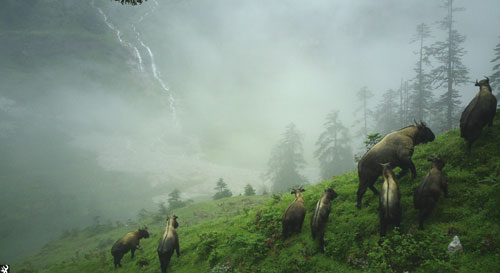 The department makes substantial contributions to the
regular teaching, training and research activities of WII. The conservation projects include research on Elephants,
monitoring endangered carnivores, mountain ungulates, red pandas, clouded leopards, primates, olive Ridley turtles;
and pheasants in the Himalaya and listing of species in the IUCN red lists and reviewing the listing in the
schedules of the Indian Wildlife (Protection) Act.
The department makes substantial contributions to the
regular teaching, training and research activities of WII. The conservation projects include research on Elephants,
monitoring endangered carnivores, mountain ungulates, red pandas, clouded leopards, primates, olive Ridley turtles;
and pheasants in the Himalaya and listing of species in the IUCN red lists and reviewing the listing in the
schedules of the Indian Wildlife (Protection) Act.
Currently, the faculty members of the department are involved in many research projects dealing with the ecology and monitoring of endangered species in a wide range of study areas from the high Himalaya to the coasts and islands and the southern Indian Ocean and Antarctica. A few projects also involve working with managers and local indigenous communities to resolve human–wildlife interface issues.
Vision and Objectives
The Department of Endangered Species Management (ESM) has the mandate to work for the conservation of rare and endangered species of India through status surveys, research, monitoring, development of conservation action plans and advocacy
Activities
- National Mission on Sustaining the Himalayan Ecosystem – Task Force IV
- National Mission on Himalayan Studies: Human-Wildlife Conflict Management in the Indian Himalayan Region
- SECURE Himalaya Project
- PAN India Assessment and Monitoring of Endangered Species under the Integrated Development of Wildlife Habitats (IDWH) - Red Panda and Clouded Leopards
- Ecology and Conservation of Mishmi Takin in Arunachal Pradesh
- Ecosystem Services of Colonial Nesting Waterbirds
- Conservation Advisory and Policy on Linear Infrastructures, Mining and other developmental projects in India
- Compiling Wildlife Conservation Plans in lieu of forestland diversion for pumped storage hydroelectricity projects in Rajasthan and Uttar Pradesh
- Ecological sensitive zone studies & development of Conservation Plan for Kaiga
- Atomic Power Project Unit 5&6, District Uttarkanada, Karnataka
- Study the various impacts that may occur due to the De-silting of Harike Wetland
- Landscape scale assessment of habitat population and Genetic structure of hispid hare in highly fragmented Terai Grassland of India.
- Integrated Conservation & Management Strategies for Chirang-Ripu Elephant Reserve: A multifaceted approach
- Assessment of Human – Wildlife Interactions with a specific focus on actions for Mitigating the Human – Elephant Conflict in Wokha and Mokokchung Districts, Nagaland
- Systematics and Biogeography of Herpetofauna of Northeast India. Supported by SERB-DST, Govt of India, National Geographic Explorer Grant, Meghalaya Biodiversity Board
- Batagur baska conservation Project. Supported by IDWH Scheme of MoEFCC and West Bengal Forest Department
- A comprehensive study on the Ecology and Population Status of a human commensalthe House Sparrow Passer domesticus in the Uttarakhand state
- Understanding the nearshore and migratory movements of Green Sea turtles (Chelonia mydas) and Hawksbill Sea turtles (Eretmochelys imbricata) from the Lakshadweep islands
- Tracking movements and population assessment of nesting seabirds in the Pitti Island Bird Sanctuary and other islands of the Lakshadweep Archipelago – A Pilot Initiative
- PAN India Assessment and Monitoring of Endangered Species under the Integrated Development of Wildlife Habitats (IDWH) - Marine Turtle, Vulture, Nicobar Megapode, Andaman Swiftlet, Jerdon’s Course
- Comprehensive population assessment of Waterbirds and track movements of select species of the Wular Lake and adjoining areas
- Satellite tracking Amur falcons Falco amurensis from their stop-over sites in Manipur to support conservation efforts
Publications
- Ahmad, A and Gopi.G.V (2024). Site occupancy of select mammals in the tropical forest of Eastern Himalaya. Frontiers in Ecology and Evolution. 11:1106329. doi: https://doi.org/10.3389/fevo.2023.1106329
- Kaur S., Gopi G.V., & Uniyal V.P., 2024. Grouping and home-range of the Vulnerable Great Slaty Woodpecker Mulleripicus pulverulentus in the western Himalaya. Indian BIRDS 19 (6): 180–184
- Kaur, S., Gopi. G.V and Uniyal V.P (2023). Colour aberration in the Great Slaty Woodpecker Mulleripicus pulverulentus from Pawalgarh Conservation Reserve, Uttarakhand. Indian BIRDS Vol . 19 No . 4. 116-118
- Jha, R.R.S., Gopi.G.V., Chetri.D and Nandha Kumar (2023). Rerouting railway would conserve India's gibbons. Science. Vol 381, Issue 6660 p. 843. DOI: https://doi.org/10.1126/science. adj5002. IF 56.9
- J.R. Deka., Sk.Z. Ali., M. Ahamad., P. Borah., Gopi.G.V., R. Badola., R. Sharma. and S.A. Hussain (2023). Can Bengal Tiger (Panthera tigris tigris) endure the future climate and land use change scenario in the East Himalayan Region? Perspective from a multiple model framework. Ecology and Evolution. Vol 13 (8). e10340. https://doi.org/10.1002/ece3.10340. IF 3.2
- R. Kanagaraj., B. D. Joshi., R. De., M. A. Predit., S. K. Singh., P. Pandey., V. Kumar., V. Sharma., M. Kumar., R. Matura., B. Pandav., P. Nigam., R. Sharma., B. Habib., Gopi. G. V., A. Trabucco., T. Wiegand and S. P. Goyal. (2023). Predicting the impact of climate change on range and genetic diversity patterns of the endangered endemic Nilgiri tahr (Nilgiritragus hylocrius) in the western Ghats, India. Landscape Ecology. 38, 2085–2101 (2023). IF 5.3
- Ahmad A, Kanagaraj R, Gopi GV. Wildlife habitat mapping using Sentinel-2 imagery of Mehao Wildlife Sanctuary, Arunachal Pradesh, India. Heliyon. 2023 Feb 20;9(3):e13799. doi: https://doi.org/10.1016/j.heliyon.2023.e13799. IF 4.0
- Gitima D, K M Selvan, B P Lahkar, Gopi G V (2022). Effectiveness of physical barriers in mitigating human-elephant negative interactions in North-East India Frontiers in Conservation Science. . 3:956568. doi: https://doi.org/10.3389/fcosc.2022.956568
- Frank SJD, Gopi G V, Lakshminarayanan N and Pandav B. (2022). Factors influencing occurrence and species richness of heronries in wetlands of Tamil Nadu. Wetlands. 42, 11. https://doi.org/10.1007/s13157-022-01531-z. IF 2.0
- Devi A, Hussain S A, Sharma M, G V Gopi and Badola, R. (2022). Scientific Reports, 12:482. https://doi.org/10.1038/s41598-021-04295-4. IF 4.9
- Frank SJD, Gopi GV, Pandav B. 2021. Heronry distribution and site preference dynamics of tree-nesting colonial waterbirds in Tamil Nadu. PeerJ 9:e12256 DOI: https://doi.org/10.7717/peerj.12256 IF 3.0
- S K Arya and Gopi G V (2021). Influence of season and habitat on birds in a mid-altitudinal village ecosystem of Kailash Sacred Landscape-India. Environmental Challenges (Vol 5). https://doi.org/10.1016/j.envc.2021.100317
- S K Arya, G S Rawat and Gopi G V (2021). Distribution and Abundance of Raptors in Kailash Sacred Landscape, Western Himalaya, India. Proceedings of the Zoological Society volume 74, pages327–338. https://doi.org/10.1007/s12595-021-00377-3
- Frank, S.J.D., Gopi, G.V., Sankar, K and S A Hussain (2021) Dry season resource selection among sympatric ungulates in a tropical coastal landscape: implications for conservation and management. Tropical Ecology 62, 418–426 (2021). https://doi.org/10.1007/s42965-021-00156-3
- Arya S K and Gopi G V (2021). An annotated bird checklist of community-managed lands in Kailash Sacred Landscape-India, Kumaon Himalaya. Check List 17 (2): 365–383. https://doi.org/10.15560/17.2.365
- Kaur, A., Jacob, A., Mehta, D. and Kumar, R.S. (2024). Prey Species in the Diet of the Amur Falcon (Falco amurensis) during Autumn Passage Stopover in Northeast India. Journal of Raptor Research, Vol. 58 (3)
- de Zwaan, D.R., Scridel, D., Altamirano, T.A., Gokhale, P., Kumar, R.S., Sevillano-Ríos, S., Barras, A.G., Arredondo-Amezcua, L., Asefa, A., Carrillo, R.A. and Green, K., & Martin, K. (2022). GABB: A global dataset of alpine breeding birds and their ecological traits. Scientific data, 9(1), 627
- Taneja, Y. V., Page, N. V., Kumar, R. S., & Naniwadekar, R. (2022). Effects of canopy cover on fruiting intensity and fruit removal of a tropical invasive weed. Forest Ecology and Management, 523, 120502
- Prakash, H., Kumar, R. S., Lahkar, B., Sukumar, R., Vanak, A. T., & Thaker, M. (2022). Animal movement ecology in India: insights from 2011–2021 and prospective for the future. PeerJ, 10, e14401.
- Magory Cohen, T., Major, R. E., Kumar, R. S., Nair, M., Ewart, K. M., Hauber, M. E., & Dor, R. (2021). Rapid morphological changes as agents of adaptation in introduced populations of the common myna (Acridotheres tristis). Evolutionary Ecology, 35, 443-462
- Cohen, T. M., Kumar, R. S., Nair, M., Hauber, M. E., & Dor, R. (2020). Innovation and decreased neophobia drive invasion success in a widespread avian invader. Animal Behaviour, 163, 61-72
- Piross, I. S., Siliwal, M., Kumar, R. S., Palatitz, P., Solt, S., Borbáth, P., Vili, N., Magonyi, N., Vas, Z., Rózsa, L. and Harnos, A. (2020). Sex interacts with age-dependent change in the abundance of lice-infesting Amur Falcons (Falco amurensis). Parasitology Research, 119, 2579-2585
- Singh, A., Gupta, S. K., Alström, P., Mohan, D., Hooper, D. M., Kumar, R. S., Bhatt, D., Singh, P. and Price, T. D. (2020). Taxonomy of cryptic species in the Cyornis rubeculoides complex in the Indian subcontinent. Ibis, 162(3), 924-935
- Justa, P., Kumar, R. S., Talukdar, G., & Sinha, A. (2019). Sharing from the same bowl: resource partitioning between sympatric macaque species in the western Himalaya, India. International Journal of Primatology, 40, 356-373
- Boruah, B. Narayanan, S., Gerard, J. D., Das A. & Deepak V. (2023) Discovery of a new species of dwarf frog (Anura: Ceratobatrachidae: Alcalus) extends the northwestern distributional limits of the genus to Northeast India, Systematics and Biodiversity, 21:1, 2249891, DOI: https://doi.org/10.1080/14772000.2023.2249891
- Boruah, B., Deepak, V., Patel, N. G., Jithin, V., Yomcha, T., & Das, A. (2023). A new species of green tree frog of the genus Gracixalus (Anura: Rhacophoridae) from the evergreen forest of Northeast India. Vertebrate Zoology, 73, 557-574. https://doi.org/10.3897/vz.73.e98444
- Boruah, B. Deepak V. & Das A. (2023) Musicians in the marsh: a new species of music frog (Anura: Ranidae: Nidirana) from Arunachal Pradesh, India. Zootaxa 5374 (1): 051–073. DOI: https://doi.org/10.11646/zootaxa.5374.1.3
- Gautam K. B, Kumar A, Das A, Gupta S. K (2023). Himalayan upliftment and Shiwalik succession act as a cradle for divergence in Bengal monitor lizard Varanus bengalensis (Reptilia: Varanidae) in India. Cladistics. DOI: https://doi.org/10.1111/cla.12542
- Dolia, J., Das, A., & Kelkar, N. (2023). House-warming: Wild king cobra nests have thermal regimes that positively affect hatching success and hatchling size. Journal of Thermal Biology, 112, 103468. DOI: https://doi.org/10.1016/j.jtherbio.2023.103468
- Das, A. Gower, D.J, Narayanan, S. Pal, S. Boruah B. Magar S. Das, Moulick, S. Deepak, V. 2022. Rediscovery and systematics of the rarely encountered Blue-bellied kukri snake (Oligodon melaneus Wall, 1909) from Assam, India. Zootaxa 5138 (4): 417–430. DOI: https://doi.org/10.11646/zootaxa.5138.4.4
- Jithin V, Johnson J. A, Das A 2022. Influence of check dams on the activity pattern and morphometric traits of overwintering tadpoles in the Western Himalaya. Limnologica 95:125992 DOI: https://doi.org/10.1016/j.limno.2022.125992
- Das, A, Smith, E.N., Sidik, I., Sarker, G.C., Boruah, B., Patel, N., Murthy, B.H.C.K. and Deepak, V., (2021). Hidden in the plain sight: a new species of Rhabdophis (Serpentes: Natricinae) from the Rhabdophis himalayanus complex. Zootaxa, 5020(3), pp.401-433. DOI: https://doi.org/10.11646/ZOOTAXA.5343.2.1
- Das A, Deepak V, Captain A, Edward E.O Z & Gower D.J (2020) . Description of a new species of Smithophis Giri et al. 2019 (Serpentes: Colubridae: Natricinae) from Arunachal Pradesh, India. Zootaxa 4860 (2): 267–283. DOI: https://doi.org/10.11646/zootaxa.4860.2.8
- Das, A. Gower D. J. Deepak V. (2020). Lost and Found: rediscovery and systematics of the Northeast Indian snake Hebius pealii (Sclater, 1891). Vertebrate Zoology. 70(3): 305–318. DOI: https://doi.org/10.26049/VZ70-3-2020-04 [1.75]
- Patel N and Das A. (2020). Shot the Spot: A reliable field method for identification of Amolops formosus (Anura: Ranidae). Herpetozoa. 33:7-15 10.3897/Herpetozoa@47279 [0.84]
- Nath, A., Lahkar, B. P., Brahma, N., Sarmah, P., Das, A., Das, S., Basumatary, T., Islari, R., & Swargowari, A. (2023). Breaking dawn: Factors influencing mammalian habitat usage in western Assam following socio-political instability. Journal for Nature Conservation, 72, 126357. https://doi.org/10.1016/j.jnc.2023.126357
- Nath, A., Singha, H., & Lahkar, B. P. (2022). Correlation does not imply causation: Decline of house sparrow overshadowed by electromagnetic radiation. Urban Ecosystems, 25, 1279–1295. https://doi.org/10.1007/s11252-022-01227-6
- Nath, A., Singha, H., Haque, M., & Lahkar, B. P. (2022). How many sparrows are there in a city of million people? Understanding the population of sympatric sparrows in the urban gradient of a tropical city in Southeast Asia. Urban Ecosystems, 25, 1065–1081. https://doi.org/10.1007/s11252-022-01210-1
- Nath, A., Haque, M., & Lahkar, B. P. (2019). Sparrows in urban complexity: Macro and micro-scale habitat use of sympatric sparrows in Guwahati City, India. Urban Ecosystems, 22, 1047–1060. https://doi.org/10.1007/s11252-019-00876-4
- Nath, A., Singha, H., Deb, P., Das, A. K., & Lahkar, B. P. (2016). Nesting in a crowd: Response of house sparrow towards proximity to spatial cues in commercial zones of Guwahati City. Proceedings of Zoological Society, 69, 249–254. DOI: https://doi.org/10.1007/s12595-015-0149-4
- Nath, A., Sinha, A., Lahkar, B. P., & Brahma, N. (2019). In search of aliens: Factors influencing the distribution of Chromolaena odorata L. and Mikania micrantha Kunth in the Terai grasslands of Manas National Park, India. Ecological Engineering, 131, 16–26
- Sinha, A., Nath, A., Lahkar, B. P., Brahma, N., Sarma, H. K., & Swargowari, A. (2022). Understanding the efficacy of different techniques to manage Chromolaena odorata L., an invasive alien plant in the sub-Himalayan tall grasslands: Toward grassland recovery. Ecological Engineering, 179, 106618. https://doi.org/10.1016/j.ecoleng.2022.106618
- Nath, A., Chakraborty, P., Sarkar, V., Joshi, C., Bhadouria, B. S., Kakati, N., Ghosh, S., & Talukdar, G. (2022). Monitoring Outstanding Universal Value: An analysis of the status of natural world heritage sites in India. Journal of Heritage Management, 7(1), 37–62
- Muliya, S. K., Nath, A., Kumar, G. C., Visvanathan, A., Selvan, M., Gowda, R., Santra, V., & Das, A. (2021). Addressing Wallacean shortfall using small sampling approach: A case study with endemic Lycodon flavicollis (Squamata: Colubridae) Mukherjee & Bhupathy, 2007. Journal of Asia-Pacific Biodiversity, 14(2), 159–168. https://doi.org/10.1016/j.japb.2020.12.005
- Khan, S., Nath, A., & Das, A. (2020). The distribution of the elongated tortoise (Indotestudo elongata) on the Indian subcontinent: Implications for conservation and management. Herpetological Conservation and Biology, 15(1), 212–227
- Pal, R., Thakur, S., Arya, S., Bhattacharya, T., & Sathyakumar, S. 2020. Mammals of the Bhagirathi basin, Western Himalaya: understanding distribution along spatial gradients of habitats and disturbances. Oryx, Cambridge University Press. https://doi.org/10.1017/S0030605319001352
- Naha, D., Dash, S.K, Chettri, Chauhdary, P., Sonker, G., Heurich, M. Rawat, G. S., and Sathyakumar, S., 2020. Landscape predictors of human-leopard conflicts within multi-use areas of the Himalayan regon. Scientific Reports 10:11129. DOI: https://doi.org/10.1038/s41598-020-67980-w
- Thakur, M., Fernandes, M., Singh, S.K., Vijh, R.K., Han, J., Wu, D, and Zhang, Y. 2018. Understanding the cryptic introgression and mixed ancestry of Red Junglefowl in India. PLoS ONE 13 (10): e0204351. DOI: https://doi.org/10.1371/journal.pone.0204351
- Pande, A., Sivakumar, K., Sathyakumar, S., Suresh Kumar, K, Johnson, J.A., Mondol, S., and V.B. Mathur. 2017. Monitoring Wildlife and their Habitats in the Southern Ocean and Around Indian Research Stations in Antarctica. Proc Indian Natn Sci Acad 83 No.2 June Thematic Issue 2017 pp.483-496
- Sathyakumar, S. and Bashir, T. 2013. Wildlife of the Himalaya: Conservation Issues and the Way Forward (IN) Arora, S., Negi, B.S., Bhan, S., Bali, J.S., and Bharti, V.K. (Eds.). Mountain People and their Environment. Soil Conservation Society of India, New Delhi. Pp322-343
- Sathyakumar, S. 2001. Status and Management of Asiatic Black Bear and Brown Bear in India. URSUS. Vol.12: 21-30



